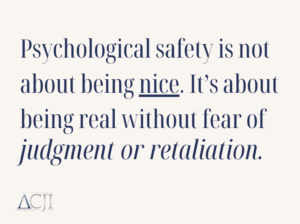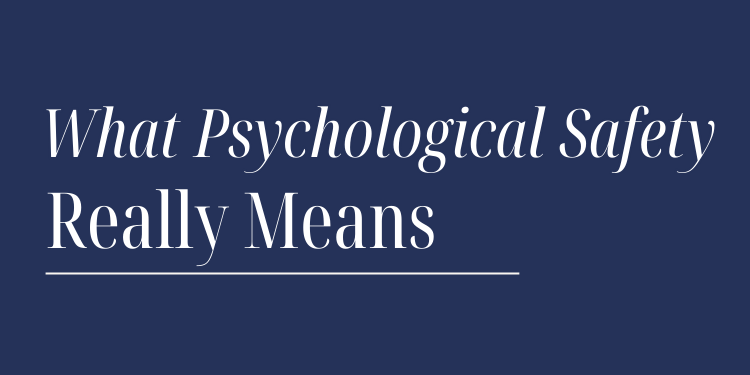Too often, psychological safety is treated like a buzzword. At ACJI, we see it as the foundation of a healthy workplace. Find out what it means for you and your organization.
Part 1: What Psychological Safety Really Means
The term “psychological safety” is frequently mentioned in leadership training and staff meetings these days. But it’s not just a buzzword or the latest and greatest trend in organizational development. At ACJI, we see it as the foundation of healthy workplaces. It always has been.
We define psychological safety as the integrated tension between belonging and autonomy. It’s the freedom to be your real self and to know you’re part of something bigger. It’s not just the absence of fear. It’s the presence of connection.
Belonging Plus Autonomy
- Belonging means you feel included, respected, and connected to your peers. You know your voice matters and that you’re part of the group’s purpose.
- Autonomy means you can be authentic, show your personality, share ideas, admit mistakes, and even challenge the status quo.
Psychological safety is not about being nice. It’s about being real without fear of judgment or retaliation.

Why It Matters in Criminal Justice and Human Services
In high-pressure environments like probation, corrections, or behavioral health, staff face daily trauma and tough decisions. Without psychological safety among the organization’s staff, people stay silent, hide mistakes, and disengage.
With psychological safety, though, organizations see:
- More honest communication
- Better problem-solving
- Stronger resilience during reform
- Lower burnout and turnover
Six Dynamics of Psychological Safety
ACJI has developed a model that breaks psychological safety into six dynamics:
- Authentic Self-Expression – I can be my real self here.
- Authentic Growth – Mistakes are part of learning.
- Connected Inclusion – I belong in this group.
- Contribution – My ideas matter.
- Authentic Voice – I can challenge respectfully.
- Co-Elevation – I can help lift others up.
These dynamics show up in small, everyday behaviors: admitting you don’t know something, laughing naturally, inviting quiet voices to contribute, or respectfully challenging a decision.
Practice Recognizing Red Flags and Green Flags
Hopefully, after reading this, you now have a better understanding of what psychological safety is and what it isn’t. Your task now is to look for the green flags and red flags so you can become more aware of your behavior and your organization’s culture. Start by looking for the green and red flags.
- Green Flags: People admit mistakes, leaders model vulnerability, and everyone gets a chance to speak. (Learn more about green flags in the third article in this series.)
- Red Flags: Silence, cliques, punishing mistakes, or quick groupthink that shuts down real discussion.

To Sum Up
Psychological safety isn’t soft. It’s the foundation of high-performing, healthy organizations. It’s how people belong fully, grow freely, and elevate together.
At ACJI, we believe culture change begins with safety. If you’re curious about how to build it in your team or agency, stay tuned for Part 2 of this series: “Pseudo-Silence — The Quiet Enemy of Culture Change and Psychological Safety.”
Want to go even deeper? ACJI is launching its Culture Academy in November 2025, a 10-week program that takes leaders and teams from culture talk to culture action. Learn more on our website here.





